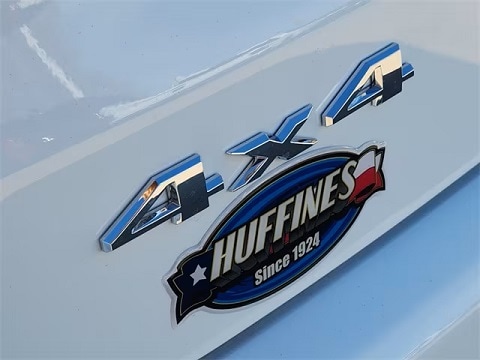

When you're looking to purchase a new vehicle, you may often hear terms such as all-wheel drive (AWD), four-wheel drive (4WD), and front-wheel drive (FWD) but are unsure what they mean. These refer to different drivetrains, and they all serve different purposes depending on what you use your vehicle for. Understanding these differences can help you make an informed choice when purchasing a vehicle. In this article, our experts at Huffines Chrysler Jeep Dodge Ram (CJDR) Plano explore each drivetrain type, explain how they work, their advantages and disadvantages, and highlight their differences.
What Is 4WD?
4WD is a drivetrain system that sends power to all four wheels of a vehicle simultaneously while on the road. The 4WD system is primarily designed for off-road conditions and rugged terrains such as mountainsides or valleys. Vehicles with 4WD are ideal if you spend time driving on dirt roads, snowy mountains, or rocky trails.
How 4WD Works
4WD is available in part-time and full-time systems:
- Part-time 4WD: This system requires you to manually engage it to distribute power from the engine equally between the front and rear axles, allowing all four wheels to move the vehicle forward. When you don't need it, you can switch back to two-wheel drive (2WD) to conserve fuel.
- Full-time 4WD: Full-time 4WD is always active. This means that the engine constantly drives all four wheels without requiring you to engage the system.
Many modern 4WD vehicles also include low-range gearing. This is useful for climbing steep hills, towing heavy loads, or getting out of tough situations such as deep snow or mud.
Pros of 4WD
Some of the advantages of 4WD include the following:
- Off-road capability: 4WD is ideal for off-roading since it improves traction and control in tough driving and weather conditions.
- Towing power: 4WD vehicles usually have better towing capacities to pull heavy loads.
Cons of 4WD
While a 4WD vehicle provides stability and traction, it also has several disadvantages, such as the following:
- Increased fuel consumption: Since the vehicle constantly requires power to be delivered to all four wheels, it usually consumes more fuel.
- Heavier vehicles: 4WD systems require additional components that add weight, affecting handling and fuel economy.
- Higher cost: 2WD vehicles usually cost more due to their complexity.
What Is AWD?
AWD systems are similar to 4WD since they also power all four wheels of the vehicle. The key difference is that AWD systems are designed more for on-road driving than off-road adventures.
How AWD Works
AWD systems are typically always active since they use a set of sensors and electronic controls to determine how much power to send to each wheel to adapt to the driving conditions. This system can be useful in rain, ice, or light snow.
The main AWD systems include the following:
- Full-time AWD: Similar to 4WD, power is constantly distributed between the front and rear wheels to enhance traction.
- Part-time AWD: Most of the time, these vehicles operate in 2WD. When the system detects a loss of traction, it automatically sends power to the other wheels for a better grip.
Pros of AWD:
AWD offers the following advantages:
- Better traction on slippery roads: AWD systems enhance grip in wet, icy, or snowy conditions.
- Improved handling: AWD improves vehicle stability on highways and winding roads by distributing power more evenly to each wheel.
Cons of AWD:
The disadvantages of AWD include the following:
- Higher fuel consumption: While AWD is more efficient than 4WD, it still consumes more fuel.
- No off-road capabilities: AWD systems aren't suitable for off-road adventures.
What Is FWD?
FWD is the most common drivetrain in cars today. In an FWD system, the engine sends power only to the front wheels.
How FWD Works
In an FWD vehicle, the engine's power is only delivered to the front axle to drive the front wheels. This helps to improve fuel efficiency and is ideal for everyday urban and suburban driving. Since the front wheels are responsible for both steering and pulling the car forward, this can increase stability in normal driving conditions.
Pros of FWD:
Some of the advantages of FWD include the following:
- Fuel efficient: FWD vehicles are more fuel-efficient since the drivetrain is simpler.
- Lower cost: FWD vehicles are usually more affordable to produce, purchase, and maintain.
Cons of FWD:
The disadvantages of FWD include the following:
- Less traction on slippery surfaces: Since only the front wheels receive power, FWD vehicles may struggle in slippery conditions such as snow or ice.
- Not ideal for off-roading: FWD vehicles aren't suitable for off-road conditions and lack the capability of 4WD or AWD systems.
How Do 4WD and AWD Compare to FWD?
Your choice of a 4WD, AWD, or FWD vehicle will depend on the driving you plan to do. 4WD is designed for rugged terrains and extreme conditions such as rocky paths and mud, while the FWD is suitable for everyday driving on paved roads. AWD strikes a balance between the two, offering traction and stability in a variety of road conditions. Vehicles with 4WD and AWD will definitely be pricier than FWD, with the latter offering better fuel efficiency.
Discover the Difference at Huffines CJDR Plano
Choosing the drivetrain you want depends on your lifestyle, driving habits, and environment. At Huffines CJDR Plano, we have a wide selection of vehicles featuring 4WD, AWD, and FWD systems. If you're in the Plano, Texas, area, make an appointment to test-drive some of our vehicles and find the perfect fit for your needs. Our team will guide you through the various drivetrains and help you make the right choice for your next vehicle.